2,5-二甲基噻二唑 | 27464-82-0
-
物化性质
-
计算性质
-
ADMET
-
安全信息
-
SDS
-
制备方法与用途
-
上下游信息
-
文献信息
-
表征谱图
-
同类化合物
-
相关功能分类
-
相关结构分类
物化性质
-
熔点:35-39 °C(lit.)
-
沸点:202-203 °C
-
密度:1.176 (estimate)
-
稳定性/保质期:
如果遵照规格使用和储存,则不会分解。避免接触氧化物。
计算性质
-
辛醇/水分配系数(LogP):0
-
重原子数:7
-
可旋转键数:0
-
环数:1.0
-
sp3杂化的碳原子比例:0.5
-
拓扑面积:54
-
氢给体数:0
-
氢受体数:3
安全信息
-
TSCA:Yes
-
危险品标志:Xi
-
危险类别码:R36/37/38
-
WGK Germany:3
-
海关编码:2934999090
-
安全说明:S26,S36
-
储存条件:将贮藏器密封,放入一个紧密的容器中,并存放在阴凉、干燥处。
SDS
模块 1. 化学品
产品名称: 2,5-Dimethyl-1,3,4-thiadiazole
修改号码: 2
模块 2. 危险性概述
GHS分类
物理性危害 未分类
健康危害
皮肤腐蚀/刺激 第2级
严重损伤/刺激眼睛 2A类
环境危害 未分类
GHS标签元素
图标或危害标志
信号词 警告
危险描述 造成皮肤刺激
造成严重眼刺激
防范说明
[预防] 处理后要彻底清洗双手。
穿戴防护手套/护目镜/防护面具。
[急救措施] 眼睛接触:用水小心清洗几分钟。如果方便,易操作,摘除隐形眼镜。继续冲洗。
眼睛接触:求医/就诊
皮肤接触:用大量肥皂和水轻轻洗。
若皮肤刺激:求医/就诊。
脱掉被污染的衣物,清洗后方可重新使用。
模块 3. 成分/组成信息
单一物质/混和物 单一物质
化学名(中文名): 2,5-二甲基-1,3,4-噻二唑
百分比: >98.0%(N)
CAS编码: 27464-82-0
分子式: C4H6N2S
2,5-二甲基-1,3,4-噻二唑 修改号码:2
模块 4. 急救措施
吸入: 将受害者移到新鲜空气处,保持呼吸通畅,休息。若感不适请求医/就诊。
皮肤接触: 立即去除/脱掉所有被污染的衣物。用大量肥皂和水轻轻洗。
若皮肤刺激或发生皮疹:求医/就诊。
眼睛接触: 用水小心清洗几分钟。如果方便,易操作,摘除隐形眼镜。继续清洗。
如果眼睛刺激:求医/就诊。
食入: 若感不适,求医/就诊。漱口。
紧急救助者的防护: 救援者需要穿戴个人防护用品,比如橡胶手套和气密性护目镜。
模块 5. 消防措施
合适的灭火剂: 干粉,泡沫,雾状水,二氧化碳
特殊危险性: 小心,燃烧或高温下可能分解产生毒烟。
特定方法: 从上风处灭火,根据周围环境选择合适的灭火方法。
非相关人员应该撤离至安全地方。
周围一旦着火:如果安全,移去可移动容器。
消防员的特殊防护用具: 灭火时,一定要穿戴个人防护用品。
模块 6. 泄漏应急处理
个人防护措施,防护用具, 使用个人防护用品。远离溢出物/泄露处并处在上风处。
紧急措施: 泄露区应该用安全带等圈起来,控制非相关人员进入。
环保措施: 防止进入下水道。
控制和清洗的方法和材料: 清扫收集粉尘,封入密闭容器。注意切勿分散。附着物或收集物应该立即根据合适的
法律法规处置。
模块 7. 操作处置与储存
处理
技术措施: 在通风良好处进行处理。穿戴合适的防护用具。防止粉尘扩散。处理后彻底清洗双手
和脸。
注意事项: 如果粉尘或浮质产生,使用局部排气。
操作处置注意事项: 避免接触皮肤、眼睛和衣物。
贮存
储存条件: 保持容器密闭。存放于凉爽、阴暗处。
远离不相容的材料比如氧化剂存放。
包装材料: 依据法律。
模块 8. 接触控制和个体防护
工程控制: 尽可能安装封闭体系或局部排风系统,操作人员切勿直接接触。同时安装淋浴器和洗
眼器。
个人防护用品
呼吸系统防护: 防尘面具。依据当地和政府法规。
手部防护: 防护手套。
眼睛防护: 安全防护镜。如果情况需要,佩戴面具。
皮肤和身体防护: 防护服。如果情况需要,穿戴防护靴。
模块 9. 理化特性
固体
外形(20°C):
外观: 晶体-粉末
颜色: 白色类白色
气味: 无资料
pH: 无数据资料
2,5-二甲基-1,3,4-噻二唑 修改号码:2
模块 9. 理化特性
熔点: 无资料
沸点/沸程 无资料
闪点: 无资料
爆炸特性
爆炸下限: 无资料
爆炸上限: 无资料
密度: 无资料
溶解度: 无资料
模块 10. 稳定性和反应性
稳定性: 一般情况下稳定。
反应性: 未报道特殊反应性。
须避免接触的物质 氧化剂
危险的分解产物: 一氧化碳, 二氧化碳, 氮氧化物 (NOx), 硫氧化物
模块 11. 毒理学信息
急性毒性: 无资料
对皮肤腐蚀或刺激: 无资料
对眼睛严重损害或刺激: 无资料
生殖细胞变异原性: 无资料
致癌性:
IARC = 无资料
NTP = 无资料
生殖毒性: 无资料
模块 12. 生态学信息
生态毒性:
鱼类: 无资料
甲壳类: 无资料
藻类: 无资料
残留性 / 降解性: 无资料
潜在生物累积 (BCF): 无资料
土壤中移动性
log水分配系数: 无资料
土壤吸收系数 (Koc): 无资料
亨利定律 无资料
constaNT(PaM3/mol):
模块 13. 废弃处置
如果可能,回收处理。请咨询当地管理部门。建议在可燃溶剂中溶解混合,在装有后燃和洗涤装置的化学焚烧炉中
焚烧。废弃处置时请遵守国家、地区和当地的所有法规。
模块 14. 运输信息
联合国分类: 与联合国分类标准不一致
UN编号: 未列明
模块 15. 法规信息
《危险化学品安全管理条例》(2002年1月26日国务院发布): 针对危险化学品的安全使用、生产、储存、运输、装
卸等方面均作了相应的规定。
2,5-二甲基-1,3,4-噻二唑 修改号码:2
模块16 - 其他信息
N/A
反应信息
-
作为反应物:描述:参考文献:名称:Ohta; Isowa, Nippon Kagaku Zasshi, 1958, vol. 79, p. 1452摘要:DOI:
-
作为产物:描述:参考文献:名称:Jensen,K.A.; Pedersen,C., Acta Chemica Scandinavica (1947), 1961, vol. 15, p. 1124 - 1129摘要:DOI:
-
作为试剂:描述:2,5-二甲基噻二唑 、 水杨醛 在 2,5-二甲基噻二唑 、 methylglycol 作用下, 反应 30.0h, 以304 g (56% of theory) of yellow crystals of melting point 253°-254° are obtained的产率得到2-[(E)-2-(5-Methyl-[1,3,4]thiadiazol-2-yl)-vinyl]-phenol参考文献:名称:Amino derivatives of 2-methyl-5-(2-hydroxystyryl)-1,3,4-thiadiazole摘要:2-甲基-5-(2-羟基苯乙烯基)-1,3,4-噻二唑的新型烷基氨基丙醇衍生物及其与酸的加成盐,其制备方法,以及含有这些化合物的制药配方,可用于治疗心脏冠状动脉疾病、高血压和心律失常。公开号:US04237278A1
文献信息
-
Lithiation of five-membered heteroaromatic compounds. The methyl substituted 1,2-azoles, oxadiazoles, and thiadiazoles作者:R. G. MicetichDOI:10.1139/v70-334日期:1970.7.1
The lithiation of various methyl substituted isoxazoles, isothiazoles, pyrazoles, oxadiazoles, and thiadiazoles using n-butyllithium has been studied. Three types of reactions, namely, lateral lithiation, ring cleavage, and addition of butyllithium to the ring, have been found. 3,5-Dimethylisoxazole, 3-phenyl-5-methylisoxazole, 3,4-dimethyl-1,2,5-oxadiazole, 2,5-dimethyl-1,3,4-thiadiazole, 3-phenyl-5-methyl-1,2,4-oxadiazole, and 3,5-dimethyl-1,2,4-thiadiazole all undergo lateral lithiation to give the respective acetic acids after carboxylation. 1-Methyl-3,5-disubstituted pyrazoles form the 1-lithiomethyl derivatives, while 1-phenyl-3,5-disubstituted pyrazoles are converted to the 1-ortholithiophenyl-3,5-disubstituted pyrazoles. 4-Methylisothiazole is lithiated mainly at C-5, but also suffers ring cleavage to form 1-n-butylthio-2-cyanoprop-1-ene. Heteroaromatic compounds containing an N—S bond, such as 3,4-dimeth yl-1,2,5-thiadiazole, 4-methyl-5-phenyl-1,2,3-thiadiazole, and 3,5-dimethylisothiazole, undergo nucleophilic attack at sulfur with resulting ring cleavage. 3,5-Dimethylisothiazole produces 2-n-butylthiopent-2-en-4-one. 3-Methyl-5-phenyl-1,2,4-oxadiazole gave 3-methyl-5-phenyl-5-n-butyl-1,2,4-dihydroöxadiazole by addition to the azomethine bond. The results of these lithiations are discussed. 3-Methyl-5-lithiomethylisoxazole was converted to various derivatives. Nuclear magnetic resonance spectral analysis was used to establish the identity of the products.
各种甲基取代异噁唑、异硫唑、吡唑、噁二唑和噻二唑的锂化反应已经被研究。发现了三种类型的反应,即侧链锂化、环裂解和丁基锂加入环中。3,5-二甲基异噁唑、3-苯基-5-甲基异噁唑、3,4-二甲基-1,2,5-噁二唑、2,5-二甲基-1,3,4-噻二唑、3-苯基-5-甲基-1,2,4-噁二唑和3,5-二甲基-1,2,4-噻二唑都经历侧链锂化,在羧化后生成相应的乙酸。1-甲基-3,5-二取代吡唑形成1-锂甲基衍生物,而1-苯基-3,5-二取代吡唑转化为1-邻锂苯基-3,5-二取代吡唑。4-甲基异硫唑主要在C-5处发生锂化,但也发生环裂解形成1-正丁硫基-2-氰基丙-1-烯。含有N—S键的杂环化合物,如3,4-二甲基-1,2,5-噻二唑、4-甲基-5-苯基-1,2,3-噻二唑和3,5-二甲基异硫唑,在硫原子上发生亲核攻击,导致环裂解。3,5-二甲基异硫唑产生2-正丁硫代戊-2-烯-4-酮。3-甲基-5-苯基-1,2,4-噁二唑通过加成到偶氮亚胺键生成3-甲基-5-苯基-5-正丁基-1,2,4-二氢噁二唑。讨论了这些锂化的结果。3-甲基-5-锂甲基异噁唑被转化为各种衍生物。核磁共振光谱分析用于确定产物的身份。 -
Die Synthese von 2-Methyl-5-phenacyl-1,3,4-thiadiazolen / The Synthesis of 2-Methyl-5-phenacyl-1,3,4-thiadiazoles作者:Willi Kantlehner、Erwin Haug、Willy Kinzy、Oliver Scherr、Ivo C. IvanovDOI:10.1515/znb-2004-0403日期:2004.4.1Keywords 2,5-Dimethyl-1,3,4-thiadiazole (1a) reacts which aromatic carboxylic acid esters 8a - u in the presence of excessive sodium hydride under condensation to give sodium enolates which afford on hydrolysis the phenacyl-1,3,4-thiadiazoles 9a - u. The action of aromatic carboxylic acid chlorides on 1a in the presence of triethylamine gives rise to the formation of mixtures of diacylated thiadiazole
-
Orthoamide, LXII [1]. – Mikrowellen-unterst ¨ utzte Formylierung schwach CH<sub>2</sub>-acider Verbindungen mit dem Bredereck-Simchen Reagenz – Umwandlung der Kondensationsprodukte in Heteroaromaten / Orthoamides, LXII [1]. – Microwave Assisted Formylation of Weak CH<sub>2</sub>-Acidic Compounds with the Bredereck-Simchen Reagent – Preparation of Heteroaromatic Compounds from the Condensation Products作者:Willi Kantlehner、Gerhard Simchen、Jochen Mezger、Edmont V. Stoyanov、Ralf Kreß、Wolfgang Frey、Björn SieversDOI:10.1515/znb-2005-0218日期:2005.2.1
The diformylation of the dinitriles 4 and diesters 7 with the Bredereck-Simchen reagent HC[N(CH3)2]2[OC(CH3)3] (1) under microwave irradiation give the bis-enamines 6 and 8 with dramatically reduced reaction times and improved yields compared to conventional heating. The condensation products formed can be easily converted to bis-pyrazole and bis-isoxazole derivatives 13 and 20, respectively. Methyl anthranilate reacts on prolonged heating with the orthoamide 21 to give ketene aminal 23 in low yield (8 %). Under microwave irradiation the same reagents lead to a mixture of 23 (14 %) and dihydropyrane 24 (28 %).
-
Reactivity of heterocyclic nitrogen donors in systems containing the tetrachloroaurate(III) anion作者:Luciano Canovese、Lucio Cattalini、Michele Tomaselli、Martin L. TobeDOI:10.1039/dt9910000307日期:——same log K2versus pKa curve. There is no significant systematic steric effect on the equilibrium constants of the sort found for the more basic methyl pyridines. The complexes of the five-membered heterocyclic ligands are approximately ten times less reactive than those of the six-membered N-heterocycles of comparable basicity and exhibit steric retardation from ortho-methyl substituents. The nucleophilicities已经制备并表征了一系列[AuCl 3(L)]型的金(III)配合物(L =恶唑,苯并恶唑,噻唑,它们的苯并和甲基取代的衍生物或2-甲基苯并硒唑)。五元的N,O-N,S-和N,Se-杂环碱都通过氮与Au III结合。已在25.0°C和I = 0.20 mol dm –3(LiClO 4)的甲醇-水(95:5,v / v)中研究了氯化物置换L生成[AuCl 4 ] –的动力学。)。还已经确定了可逆过程的平衡常数。相应的吡啶,4-氯-,4-氰基-和2,6-双(氯甲基)-吡啶配合物的反应也已在相同条件下重新检查。平衡常数K 2取决于配体中氮的碱性,所有配体的点均与环的大小和组成无关,大致取决于对数K 2与p K a的关系。曲线。对于更碱性的甲基吡啶,对那种平衡常数没有明显的系统空间效应。五元杂环配体的配合物的反应性比具有相当碱性的六元N-杂环的配合物低约十倍,并且显示出由邻甲基取代基引起的空间阻滞
-
Synthesis of 1,3,4-thiadiazol-2-ylacetic acid derivatives作者:Toshinori Saito、Norio Saheki、Minoru Hatanaka、Toshiyasu IshimaruDOI:10.1002/jhet.5570200117日期:1983.11,3,4-Thiadiazol-2-ylacetic acids 4 were prepared by lithiation of 2-methyl-1,3,4-thiadiazoles 1, followed by treatment with carbon dioxide. Diethyl 1,3,4-thiadiazol-2-ylmalonates 6 were prepared by nucleophilic displacement reaction of the corresponding bromides 5 with diethyl malonate. Introduction of the amino group at the a-position of 4 or 6 was carried out via oximation or bromination to give
表征谱图
-
氢谱1HNMR
-
质谱MS
-
碳谱13CNMR
-
红外IR
-
拉曼Raman
-
峰位数据
-
峰位匹配
-
表征信息








